☑︎ This guide was last updated in November 2025
“A new online service! Let’s create an account… Username and password? Hmm, I need something I won’t forget later… I know! I’ll just use my usual password – my school nickname with a 4 instead of an A” 😎
Surely, this sounds nothing like you. Or does it?
On a more serious note, though, duplicate passwords are much riskier than weak passwords – if you’re using a single secret word for several online accounts, just one of them getting breached can lead to all others becoming compromised.
– And breaches happen all the time! Hackers usually offer the stolen passwords and other personal data for sale, which means most of it becomes public information pretty quickly:
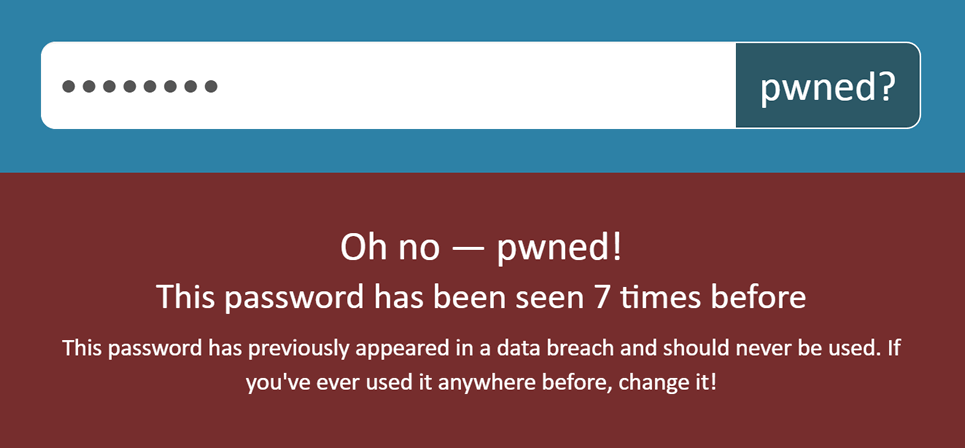
(if you’re curious, you can check if your own password has ever been stolen using this handy tool).
Password managers like NordPass are designed to insure against such unpleasant scenarios. How does it work? Is it really secure? Are the premium plans worth the money?!
Slow down, one thing at a time:
How to Use NordPass
Is NordPass Secure?
Pricing: Free vs Premium
Should You Use NordPass?
Comments and Reviews
What Is NordPass?
To put it simply, NordPass is a secure digital vault that protects your most sensitive information – passwords, codes, even credit card details.
As its name hints, NordPass was developed by NordVPN, the largest Virtual Private Network service on the planet.
NordPass consists of three software components that work together seamlessly across all your devices:
- Desktop applications for Windows, macOS, and Linux that act as the primary access point to your NordPass vault on your full-screen devices.
- Browser add-ons for Chrome, Firefox, Edge, Opera, and Brave that automatically insert your passwords and other data from your vault while you’re surfing the Web.
- Mobile apps for Android and iOS that synchronize with the primary vault and fulfill the same function on your smartphone and tablet.
NordPass encrypts your data on your device, the moment you input it, and creates backups in the cloud that allow synchronizing across all your gadgets:
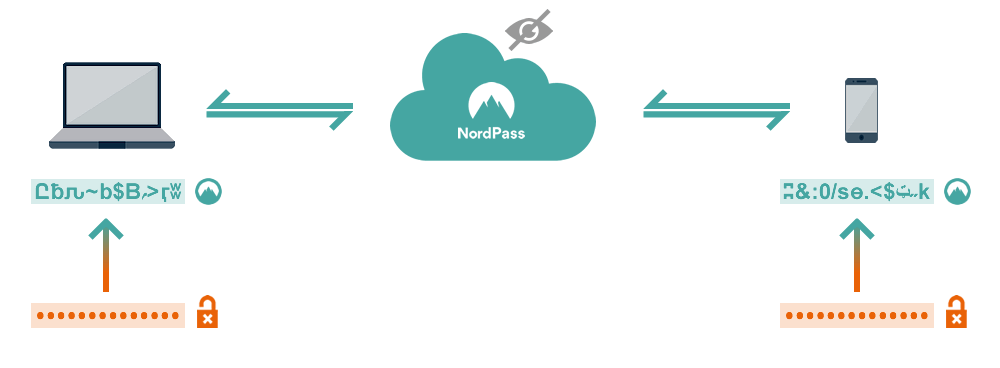
Wait, so the passwords are being sent somewhere? Doesn’t it ~ kind of ~ contradict the goal of maximum security?
In a minute, we will talk about how NordPass handles your data, but before that, let’s check out how the service works on a more practical level:
How To Use NordPass
Getting started with NordPass is fairly simple – just install the desktop application and the browser add-on using the links on the official homepage (you can add the mobile apps into the mix at any time):
Once you have both the software and the browser extension up and running, there are 3 ways to save passwords into NordPass:
Firstly, you can click the “Add Item” button in the desktop application and manually type in the required information (the same can be done by clicking on the NordPass icon in the top right corner of your browser window).
Secondly, you can import the existing saved passwords from your browser by visiting the settings area and clicking on the “Import/Export” tab:
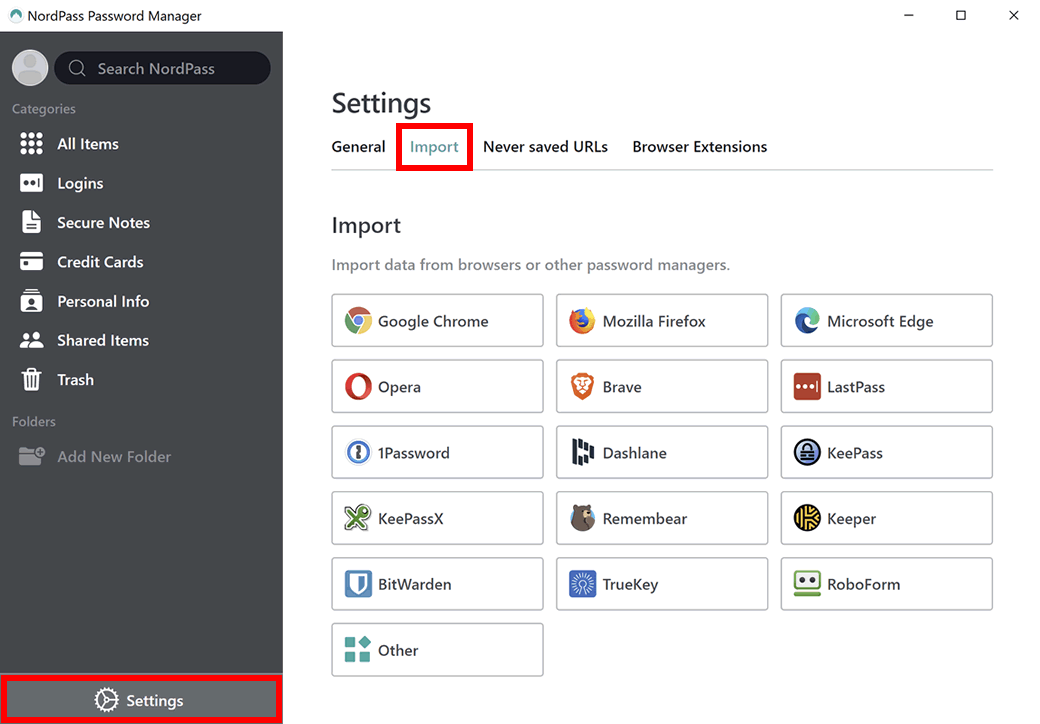
Finally (and most conveniently), NordPass will also offer to remember passwords when you first log in or create new accounts in your browser or mobile apps:
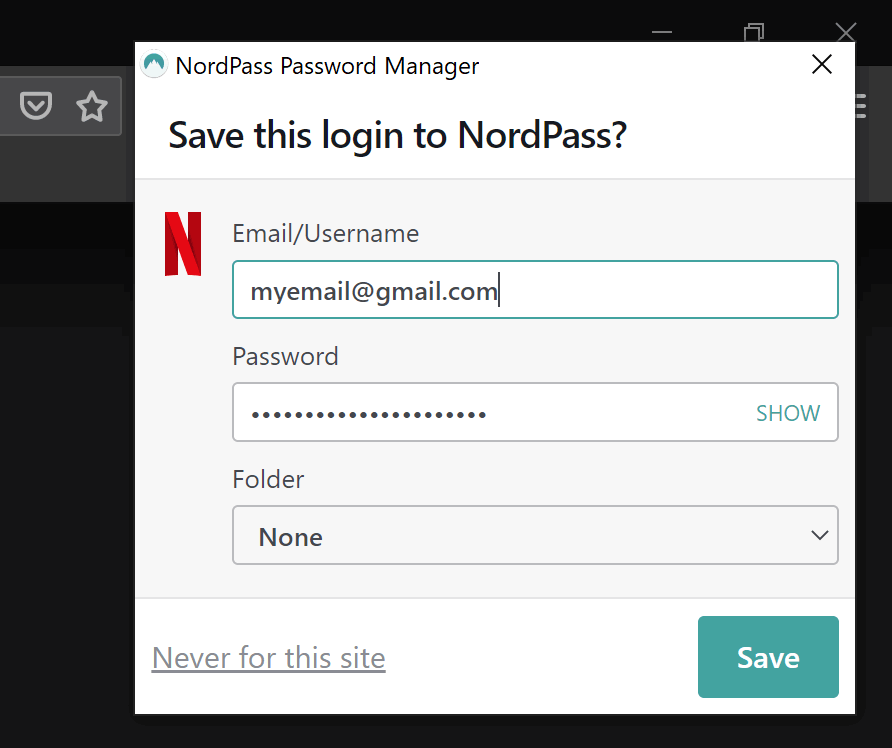
Before you save any personal data into NordPass, though, it is highly recommended to add a master password first. Why?
This looks like the right moment to discuss the security considerations in more detail:
How Secure Is NordPass?
So, how can NordPass synchronize your passwords in the cloud or allow you to share passwords with other users you trust – without compromising security along the way?
NordPass uses two key technologies to keep personal data safe across multiple devices:
- All your data is encrypted right on your machine, at the moment you save it to your vault. NordPass encrypts data with a cypher called
XChaCha20(the most modern version of the famous Salsa20) which is also utilized by Google and many large VPN services. - NordPass uses the so-called zero knowledge architecture, based on a clever technique which allows proving that one has a certain secret… without revealing the secret itself (yes, you read that right). Translation: even the folks at NordPass never see your master password.
This is why NordPass won’t really be very useful until you set up the master password, a secret combination which you – and only you – will know.
Let’s do it right now, shall we!
First, you will need to create a Nord account by visiting the Settings tab at the bottom of your NordPass desktop or mobile application.
After that the system will ask you to come up with a single mega-password that you will use to access your NordPass vault: the master password. This will be the last password you’ll need to actually memorize!
And yes, it should be long and it should be unique – otherwise we’re not really solving anything.
Tip: remember, length is more important than complexity! Instead of using a jumbled word, try a combination of 3-4 nonrelated words separated by symbols. Extra points if some of these words are proper nouns rather than dictionary words.
So, instead of Pa$$w0rd, use something like airplane*einstein*peacock – not only is it more difficult for an attacker to guess, it’s also much easier to memorize for you.
IMPORTANT: you will get recovery codes when generating your master password: write them on a piece of paper and store somewhere safe; if you forget the master password and lose those recovery codes at the same time, your vault will be unrecoverable (remember, even NordPass admins don’t have access to your data).
Another thing we highly recommend doing straight away is to add one more layer of security – namely, setting up NordPass to confirm vault access with a mobile device:
Go to settings and click on “Enable” next to “Two-Factor Authentication”; all you’ll need is to install an app like Google Authenticator on your smartphone and scan the QR-code from NordPass:

Done? Now let’s save some passwords!
After activating the NordPass browser extension you will start seeing a mountain-peak icon in login/signup fields and other online forms.
If you already have a saved password for a particular website, clicking on the icon will auto-fill the fields; if not, it will generate a unique and secure password for your new account:
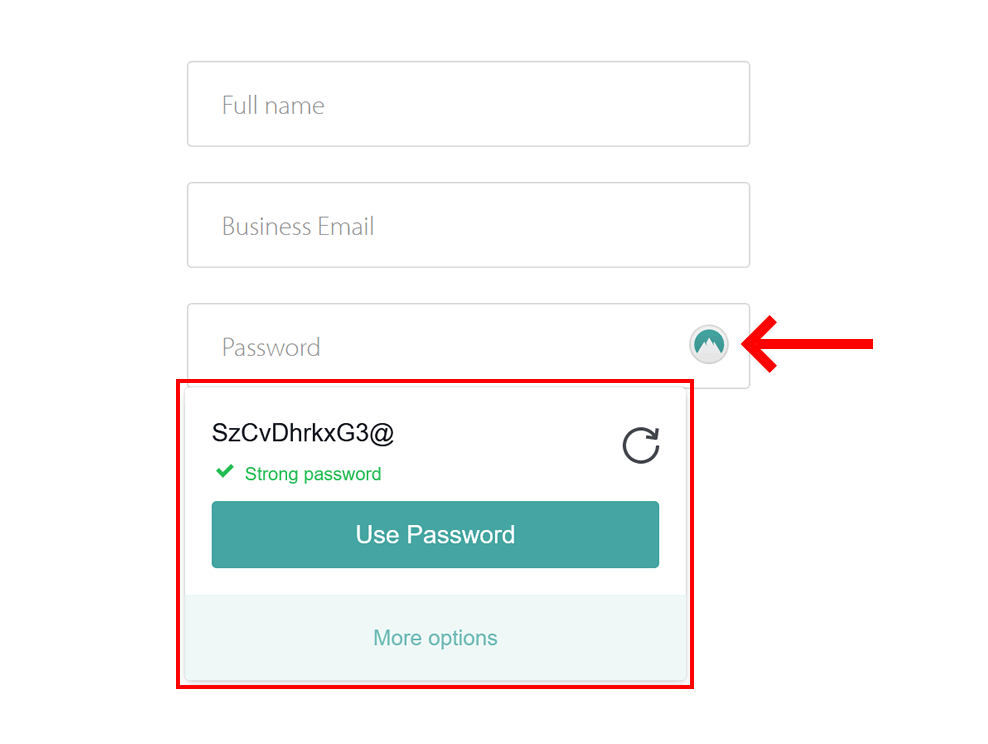
And yes, there’s no need to memorize it 🔐 you can access all your stored passwords at any time, on all your devices, using the master password and your smartphone
…which brings us to the next part of our review:
NordPass Plans: Free vs Paid
There are 3 plans available to NordPass users: Free, Premium, and Family. What should you know before choosing one?
The Free plan allows storing and accessing unlimited number of passwords and other personal data, just like we described earlier.
The Premium plan adds two things to the free version: the possibility to simultaneously use NordPass on more than 1 device, and an option to share your stored passwords with trusted contacts.
There’s a 30-day money-back guarantee, so trying Premium doesn’t really create any financial obligations for the first month of use:
The Family plan is basically just Premium with more user accounts (5, to be precise), for a single flat price – suitable for households (or business teams!) where several members are planning to use NordPass.
And yes, a single Family account costs less than two separate Premium accounts, so it’s a cheaper option even if just 2 people are planning to join 🧑🤝🧑
In order to visualize the key differences between NordPass pricing plans, take a look at this summary table:
| NordPass plan | Free | Premium | Family |
|---|---|---|---|
| Accounts included | 1 | 1 | 5 |
| Devices per account | 1 | 6 | 6 |
| Password sharing | no | yes | yes |
As you can see, the pricing logic is quite simple, which is always a plus in an online service, of course.
Now that we understand what NordPass does and how much it costs, it’s time to summarize our findings into practical recommendations –
Our Verdict: Should You Use NordPass?
Let’s start with a somewhat broader question: in general, should you use a password manager in 2025?
Definitely yes. Way safer than using the same password for all your online accounts, or keeping a manually typed list on your computer.
…Alright then, should you consider NordPass as your password manager?
Again, yes. Here are the most noteworthy reasons:
- NordPass is a brainchild of NordVPN, the largest Virtual Private Network in the world; those people know a thing or two about online privacy and security.
- Latest encryption algorithms (same as used by Google), together with the master password and double authentication, ensure that your data can be retrieved only by yourself.
- You can use NordPass completely free of charge; if you do decide to upgrade later, paid plans follow a simple logic and are priced well below competing services.
Speaking of the latter…
To be clear, the Free plan doesn’t require you to input your credit card details, and it’s free forever – so we obviously recommend starting your acquaintance with NordPass there:
Secure Your Passwords with NordPass
You can switch to Premium or Family at any time to be able to access your vault on all devices and share items with other NordPass users.
***
Or maybe you’ve already tried NordPass? In that case, do leave your impressions in the comments section below, let’s help each other make more informed decisions!

Why do password managers require the master password at all. It’s only purpose is to decrypt, why can’t we just use any password and treat nordpass just like any other site. This way master password will still be local only and entered only when we want to decrypt.
I use 5 asterisks as my password on all sites, never breached yet
if you want to start your own business this is something you will not be able to do without